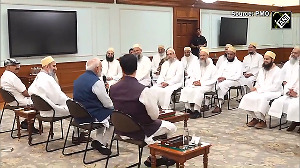Most of Vijay Kelkar's recommendations on tax restructuring have been incorporated by the finance ministry, but his politically-sensitive suggestions on direct tax rationalisation are unlikely to be implemented in an election year.
The ministry has over the year moved full speed on reforming the tax administration and restructuring indirect taxes.
However, it has not moved to eliminate exemptions in direct taxes. And this inertia is likely to carry on into Finance Minister Jaswant Singh's Budget for an election year.
The Central Board of Direct Taxes has not yet done any groundwork on the elimination of tax shelters, like saving instruments under Section 88 of the Income-Tax Act, including provident funds and post office deposits; and those under Section 80L for investment in government securities and National Savings Certificate. Instead, in the Budget for 2003-04, the CBDT added tuition fees for children to the list of eligible deductions.
For companies, Kelkar had suggested doing away with the minimum alternate tax of 8 per cent, and instead making the corporate tax rate of 35 per cent applicable to every company. None of these have come through.
The finance minister has not only maintained the corporate and income-tax rates, but has also upped the limit for standard deduction.
His agenda also included allowing a flat tax rebate of 20 per cent of income for investments under section 80CCC in pension funds.
The government, in fact, had to publicly backtrack on the issue of tax exemptions for interest payments on housing loans. Kelkar had suggested that the ceiling on the amount of mortgage interest deduction for tax should be a maximum of Rs 50,000 only.
The good news is on tax administration. The most visible indicator of change has been the issue of new smart PAN cards.
The ministry had outsourced the issue of the cards to UTI-ISL from July 1 this year.
In this fiscal, the finance ministry has also set up a National Tax Tribunal and instituted an ombudsman to handle taxpayers' grievances. It has also mandated NSDL to develop a national database of tax payers called the Tax Information Network.
The impact of the Kelkar recommendations has also been seen on indirect taxation. Though his prescription to reduce the Cenvat rate to 14 per cent from 16 per cent is pending, the median rate was reduced 5 per cent for Customs duty in the Budget for 2003-04.
With more than 80 per cent of the goods under the single Cenvat rate, changing rates was, however, not a major achievement.
Export clearance procedures is another area where quite a few recommendations made by Kelkar has been implemented within the year. The report had said the delay in Customs clearances cost the economy more than Rs 5,000 crore (Rs 50 billion) in transaction costs.
The Central Board of Excise and Customs has done away with the Budget day restriction on the movement of goods and brought in the entire textile sector, including powerlooms, under the Cenvat chain.
Multi-banking for payment of taxes has been introduced, excise collection is being done on a monthly basis instead of a fortnightly one, self-certification for export cargo has been allowed and a simplified tax return forms introduced.







 © 2025
© 2025